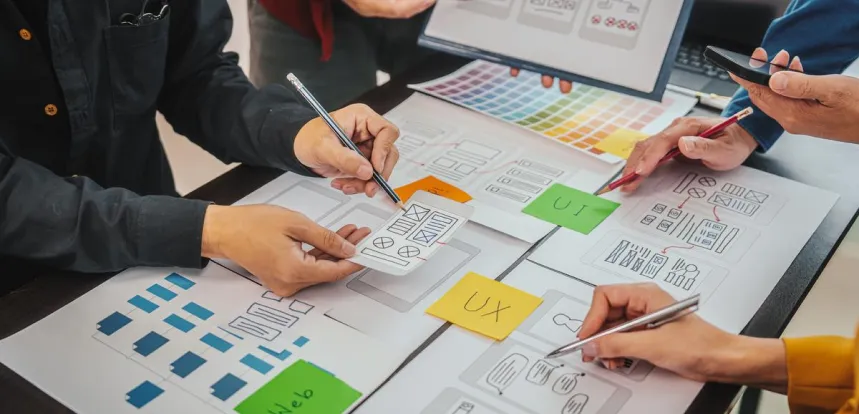We design products that look great and are user-centric. From wireframes to interactive prototypes, we create user-friendly experiences that keep people engaged and aligned with your business goals—so every interaction feels effortless.

A seamless experience from start to finish. Their attention to detail is unmatched!
- Samantha
Increase user retention with UI/UX design services by ValueCoders. We create innovative, custom-design interfaces to propel your brand forward and boost user retention. Our user-friendly product UI design helps you stand out in a crowded market.
Our team takes a holistic approach to design, ensuring that your site looks impressive and easy to navigate.
We take pride in crafting stunning visual experiences that are both meaningful and memorable.
We do usability testing to catch potential problems that users may have with your product before it goes to the market.
Experience a cutting-edge SaaS UI tailored to the tastes of your software product’s target audience.
With our design system audit services, we help you assess and refine your design components and guidelines
We help you to navigate complex design challenges through our UI/UX consulting services by provide strategic guidance.
We help you make your product stand out with intuitive, user-friendly designs that captivate and convert.

With years of industry-relevant experience, our team deeply understands the users’ needs. We conduct user research to understand what users need and want and how they think and behave.
Our team of experienced and qualified designers uses the latest software and technology to provide the best product UX/UI design and development services, focusing on customer satisfaction.
We help you increase your product's usability and appeal with cutting-edge design practices.
Partnering with businesses in diverse sectors to unlock new avenues for growth and innovation.
We specialize in engineering custom software that's both stable and secure, using a variety of tech tools.
Dive into bi-weekly sprints and rollouts aligned with project timelines.
Combined team tackles tasks, fulfilling user stories and sprint goals.
Daily check-ins led by the Scrum Master to discuss progress and tackle challenges.
Quality Engineers rigorously test new features, ensuring seamless integration.
Our team keeps the sprint backlog updated, staying on track to meet objectives.
Post-sprint reflections to refine strategies and enhance future sprints.

UI/UX design refers to the process of creating user interfaces (UI) and user experiences (UX) for digital products or services. It focuses on designing visually appealing and intuitive interfaces while ensuring a seamless and satisfying user experience.
Here’s why UI/UX development solutions & designs are important:
Overall, UI/UX design is important because it prioritizes user satisfaction, usability, brand identity, and business growth. It contributes to creating compelling, user-centered experiences that drive engagement, retention, and, ultimately, the success of a product or service.
UI (User Interface) and UX (User Experience) are closely related concepts in the design field, but they have distinct roles and focus areas. Here’s the difference between UI and UX:
User Interface (UI):
User Experience (UX):
In summary, UI design deals with the visual and interactive aspects of a product’s interface, while UX design focuses on the holistic experience and satisfaction of the users throughout their journey.
UI is about how the interface looks and feels, while UX is about how it works and meets user needs. Both UI and UX are essential for creating successful and user-centered designs.

A company should invest in UI/UX development services for several compelling reasons:

The UI/UX design and development process typically involves several stages that ensure a systematic and effective approach to creating user-centered designs. While the specific terminology and steps may vary, here are the typical stages in UI/UX design and development used by a UI/UX consulting firm :
Research and Discovery:
User Personas and User Flows:
Information Architecture and Wireframing:
Prototyping and Interaction Design:
Visual Design:
Usability Testing and Iteration:
Development Handoff:
User Testing and Iteration:
Launch and Post-Launch Evaluation:
It’s important to note that these stages often overlap, and the design process is iterative, with feedback and learnings informing subsequent stages. Collaboration between UI/UX designers, developers, and stakeholders is key to a successful design and development journey.

The UI/UX design field for mobile app development is constantly evolving. Here are some current trends that are shaping the industry:
Remember that trends can vary based on industry, target audience, and app purpose. Staying updated with these trends can help mobile app designers create innovative and user-centered experiences. You may also contact our experts as we are a leading UI/UX design company in India.
Ans. You should choose ValueCoders as your product UI/UX design company. Here are some of the reasons why:
Ans. The UI/UX design cost varies depending on the project’s complexity, scope of work, and specific client requirements. ValueCoders offers competitive pricing tailored to your project needs, ensuring cost-effectiveness without compromising quality.
Ans. Yes, we can optimize the UI/UX for your existing website and mobile app by following these steps:
Ans. At ValueCoders, we stand out with extensive expertise, a dedicated team of skilled UI/UX designers, and a client-centric approach. We focus on understanding your business goals, user needs, and market trends to deliver tailored UI/UX designs that drive engagement and business growth.
Ans. Our UI/UX design process involves thorough research, wireframing, prototyping, visual design, and usability testing. We collaborate closely with clients, ensuring transparent communication and incorporating feedback at each stage to deliver exceptional UI/UX designs that align with your vision.
Ans. Absolutely! ValueCoders has expertise in UI/UX design for both web and mobile applications. Whether you need captivating designs for responsive websites or engaging user experiences for iOS and Android apps, our team is proficient in delivering custom UI/UX design solutions across platforms.
We are grateful for our clients’ trust in us, and we take great pride in delivering quality solutions that exceed their expectations. Here is what some of them have to say about us:

Co-founder, Miracle Choice

Executive Director

Director

Director
Trusted by Startups and Fortune 500 companies
We can handle projects of all complexities.
Startups to Fortune 500, we have worked with all.
Top 1% industry talent to ensure your digital success.



Let's discuss how we can bring your vision to life.